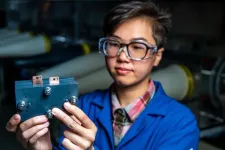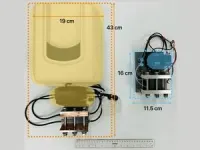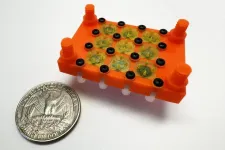(Press-News.org) RICHLAND, Wash.—Sometimes, in order to go big, you first have to go small. That’s what researchers at the Department of Energy’s Pacific Northwest National Laboratory have done with their latest innovation in energy storage.
With a goal to speed the time to discovery of new grid energy storage technology, the team designed a compact, high-efficiency flow battery test system that requires an order of magnitude less starting material while delivering results equal to the standard lab-scale test systems. The new mini flow cell design and experimental validation is described in an article published in the Journal of The Electrochemical Society. The redesigned mini flow cell closely mimics the internal structure of a traditional flow cell, scaled down by a factor of 5. But, despite its smaller size, the mini flow cell exhibits comparable performance to its larger counterpart.
Mini flow battery delivers big results
“This report is the first step, showing that scaling down our experimental system works,” said materials scientist and flow battery researcher Ruozhu Feng, a lead author of the study. “Our ultimate goal is to bring the power of AI and robotics into this process to automate and accelerate the testing of new flow battery designs.”
By reducing the amount of material needed and speeding up the validation process, this technology could help advance renewable energy solutions. Researchers also believe this miniaturized approach will facilitate experimentation with a broader range of experimental chemistries.
“Currently, we have to prepare a lot of material when we identify a promising new battery formula, and this takes a lot of time,” Feng said. “With this mini flow cell process, we can figure out whether a proposed new material works with only a tiny amount—milligrams—available.”
The mini flow cell design is geared toward research laboratories that are focused on rapid screening and development of new battery materials. In their research study, the team showed that the new mini flow cell is suitable for rapid validation of material stability. Rigorous testing over a wide range of material chemistries and concentrations helped boost researchers’ confidence in the new scaled-down system. However, the team does note that it requires highly purified starting materials that are free from impurities that could otherwise clog the narrow channels and tubes.
The research team has applied for U.S. patent protection for their new battery design. To learn more about collaboration or licensing opportunities related to the new technology, contact our commercialization team.
A team effort
The key to their success, according to lead researcher and designer of the mini flow cell, Soowhan Kim, was that the team has over a decade of experience in flow battery cell design, along with engineering, skilled machining, and chemistry experience. For example, PNNL instrumentation and systems control expert Andrey Liyu used his mechanical engineering and microfluidics experience to complete the scale down without sacrificing accuracy.
“From small cells to big stacks, we can handle all scales of flow battery design and experimentation,” said Kim, a lead research at PNNL’s Grid Storage Launchpad. “When we add the computational expertise and analytical chemistry experience, this is how we combined efforts to develop the mini flow cell. Our hope is to make this available to all researchers who are interested in using it.”
What is a flow battery?
As their name suggests, flow batteries consist of two chambers, each filled with a different liquid. The batteries charge through an electrochemical reaction and store energy in chemical bonds. When connected to an external circuit, they release that energy, which can power electrical devices. Flow batteries are a linchpin technology—they store energy from intermittent energy sources such as wind and hydroelectric power, and then release that energy on demand for grid-scale applications. Unlike traditional batteries, flow batteries use liquid electrolytes stored in external tanks, providing flexible scaling of energy capacity.
Why are new flow battery designs needed?
To make flow battery systems practical for large-scale use, researchers are seeking new chemical and material combinations that address limitations of existing systems. Some of these limitations include high material costs, low power density and the desire to source materials domestically in the United States.
How are new flow batteries discovered?
Traditionally, discovery of new materials for flow batteries has been a laborious trial-and-error process, often requiring gram-scale synthesis of organic compounds, extensive testing, and significant time investment. This new miniaturized cell design, about the size of a playing card, uses the equivalent of a few grains of sand, drastically reducing the time and resources required for each test while still delivering reliable results.
In addition to Feng, Liyu and Kim, the research team included PNNL scientists Chao Zeng, Carter C. Bracken, Yangang Liang, and principal investigator Wei Wang. This research was supported by the Energy Storage Research Alliance (ESRA), an Energy Innovation Hub funded by the U.S. Department of Energy, Office of Science, Basic Energy Sciences program and by the Energy Storage Materials Initiative, a PNNL laboratory-directed strategic research investment.
The ESRA unites leading experts from national laboratories and universities to pave the way for energy storage and next-generation battery discovery that will shape the future of power. Learn more at Energy Storage Research Alliance.
# # #
Pacific Northwest National Laboratory draws on its distinguishing strengths in chemistry, Earth sciences, biology and data science to advance scientific knowledge and address challenges in energy resiliency and national security. Founded in 1965, PNNL is operated by Battelle and supported by the Office of Science of the U.S. Department of Energy. The Office of Science is the single largest supporter of basic research in the physical sciences in the United States and is working to address some of the most pressing challenges of our time. For more information, visit the DOE Office of Science website. For more information on PNNL, visit PNNL's News Center. Follow us on Twitter, Facebook, LinkedIn and Instagram.
END
Mini flow battery speeds energy storage research
Tiny flow battery delivers outsized benefits, reducing time, cost, and resources needed for testing new battery materials
2025-02-14
ELSE PRESS RELEASES FROM THIS DATE:
Graphite production gets a makeover
2025-02-14
Collaboration efforts between the Texas A&M University Artie McFerrin Department of Chemical Engineering and the U.S. Department of Energy Advanced Research Projects Agency-Energy (ARPA-E) have led to innovative research on how petroleum coke is processed.
This almost $3 million three-year research project will convert petroleum coke to graphite for energy storage. The newer process uses a lower temperature and shorter time to produce graphite from petroleum coke.
This new catalytic graphitization technology will ...
Ancient Egyptian mummified bodies smell ‘woody,’ ‘spicy’ and ‘sweet’
2025-02-14
UCL Press Release
Under embargo until Friday 14 February 2025, 00:01 UK time / 19:01 Thursday 13 February US Eastern time
Ancient Egyptian mummified bodies smell ‘woody,’ ‘spicy’ and ‘sweet’, finds a new study led by researchers from UCL and the University of Ljubljana, revealing new details about mumification practices.
The research, published in Journal of the American Chemical Society, is the first time that the smells of mummified bodies have been systematically studied combining a mix of instrumental and sensory techniques, including an electronic ‘nose’ ...
MIT engineers develop a fully 3D-printed electrospray engine
2025-02-13
CAMBRIDGE, MA – An electrospray engine applies an electric field to a conductive liquid, generating a high-speed jet of tiny droplets that can propel a spacecraft. These miniature engines are ideal for small satellites called CubeSats that are often used in academic research.
Since electrospray engines utilize propellant more efficiently than the powerful, chemical rockets used on the launchpad, they are better suited for precise, in-orbit maneuvers. The thrust generated by an electrospray emitter is tiny, so electrospray engines typically use an array of emitters that are uniformly ...
Speculum exams unnecessary for HPV screening
2025-02-13
Genital human papillomavirus is the most common sexually transmitted infection in the United States and is thought to be responsible for more than 99% of cervical cancers.
HPV screening usually entails a speculum-based exam, which is an uncomfortable experience for most patients, especially those who have physical disabilities.
In two studies, published in Preventive Medicine Reports and JAMA Network Open, University of Michigan researchers are the first to demonstrate in the U.S. that self-sampling is just as effective as speculum-based testing for HPV detection.
Most people who have HPV are usually unaware that they have it.
By ...
Reduced prediabetes in people who ate broccoli compound
2025-02-13
The chemical compound sulforaphane found in broccoli sprouts can be linked to improved blood sugar levels in prediabetes, a precursor to type 2 diabetes. This has been shown in a study conducted at the University of Gothenburg. The broccoli compound had a more significant effect on blood sugar levels in certain people.
Researchers at the University of Gothenburg have previously identified sulforaphane as an antidiabetic agent in type 2 diabetes. A patient study conducted in 2017 demonstrated significantly lower blood sugar in people with diabetes after they took large ...
Landmark atlas reveals how aging breast tissue shapes breast cancer risk
2025-02-13
Aging is a privilege, but it also brings risks—including an increased likelihood of developing age-related diseases including cancer. Researchers at The Jackson Laboratory (JAX) have created a landmark atlas of how healthy breast tissue ages, revealing key cellular, molecular, and genetic changes that may tip the balance toward breast cancer development. Their findings, published recently in Nature Aging, provide a valuable open-access resource for the scientific community to explore aging and its role in increased cancer risk.
Rewriting ...
SHEA supports key federal advisory committees
2025-02-13
The Society for Healthcare Epidemiology of America (SHEA) urges incoming Secretary of the U.S. Department of Health and Human Services, Robert F. Kennedy Jr., to resume the federal advisory committees for key health-related priority issues as provided under the Federal Advisory Committees Act. Federal advisory committees are an important aspect of the deliberative process for reviewing important scientific information among federal agencies and members of the public as new evidence becomes available. The ability for members ...
Neurologic complications of flu nearly 50 times greater for children with underlying neurologic conditions
2025-02-13
Many clinicians do not consider neurologic complications of the flu when discussing vaccination or treatment of influenza with families.
A recent study that explored the neurologic impact of flu in children aims to change that.
“Serious Neurologic Events with Seasonal Influenza in Young Children,” published in Academic Pediatrics, the official journal of the Academic Pediatric Association, looked at the population-based incidence of underrecognized influenza-associated serious neurologic events in children less than 5 years of age.
While serious neurologic complications are uncommon in young children, the study showed a much higher incidence, ...
Killing H5N1 in waste milk — an alternative to pasteurization
2025-02-13
Pasteurization is the only widely recognized method of killing H5N1, the virus that causes bird flu, in milk. However, pasteurization can be expensive and fewer than 50% of large dairy farms pasteurize waste milk.
Waste milk includes colostrum, the first milk after calving; milk from cows treated with antibiotics or other drugs; or any other factor that can make milk unsuitable and unsellable for human consumption. On farms, raw waste milk poses a potential risk of spreading avian flu, which so far has been confirmed ...
NTT Research and Harvard scientists optimize biohybrid ray development with machine learning
2025-02-13
The Harvard John A. Paulson School of Engineering and Applied Sciences (SEAS) and NTT Research, Inc., a division of NTT, announced the publication of research showing an application of machine-learning directed optimization (ML-DO) that efficiently searches for high-performance design configurations in the context of biohybrid robots. Applying a machine learning approach, the researchers created mini biohybrid rays made of cardiomyocytes (heart muscle cells) and rubber with a wingspan of about 10 mm that are approximately two times more efficient at swimming than those recently ...
LAST 30 PRESS RELEASES:
Making lighter work of calculating fluid and heat flow
Normalizing blood sugar can halve heart attack risk
Lowering blood sugar cuts heart attack risk in people with prediabetes
Study links genetic variants to risk of blinding eye disease in premature infants
Non-opioid ‘pain sponge’ therapy halts cartilage degeneration and relieves chronic pain
AI can pick up cultural values by mimicking how kids learn
China’s ecological redlines offer fast track to 30 x 30 global conservation goal
Invisible indoor threats: emerging household contaminants and their growing risks to human health
Adding antibody treatment to chemo boosts outcomes for children with rare cancer
Germline pathogenic variants among women without a history of breast cancer
Tanning beds triple melanoma risk, potentially causing broad DNA damage
Unique bond identified as key to viral infection speed
Indoor tanning makes youthful skin much older on a genetic level
Mouse model sheds new light on the causes and potential solutions to human GI problems linked to muscular dystrophy
The Journal of Nuclear Medicine ahead-of-print tip sheet: December 12, 2025
Smarter tools for peering into the microscopic world
Applications open for funding to conduct research in the Kinsey Institute archives
Global measure underestimates the severity of food insecurity
Child survivors of critical illness are missing out on timely follow up care
Risk-based vs annual breast cancer screening / the WISDOM randomized clinical trial
University of Toronto launches Electric Vehicle Innovation Ontario to accelerate advanced EV technologies and build Canada’s innovation advantage
Early relapse predicts poor outcomes in aggressive blood cancer
American College of Lifestyle Medicine applauds two CMS models aligned with lifestyle medicine practice and reimbursement
Clinical trial finds cannabis use not a barrier to quitting nicotine vaping
Supplemental nutrition assistance program policies and food insecurity
Switching immune cells to “night mode” could limit damage after a heart attack, study suggests
URI-based Global RIghts Project report spotlights continued troubling trends in worldwide inhumane treatment
Neutrophils are less aggressive at night, explaining why nighttime heart attacks cause less damage than daytime events
Menopausal hormone therapy may not pose breast cancer risk for women with BRCA mutations
Mobile health tool may improve quality of life for adolescent and young adult breast cancer survivors
[Press-News.org] Mini flow battery speeds energy storage researchTiny flow battery delivers outsized benefits, reducing time, cost, and resources needed for testing new battery materials








